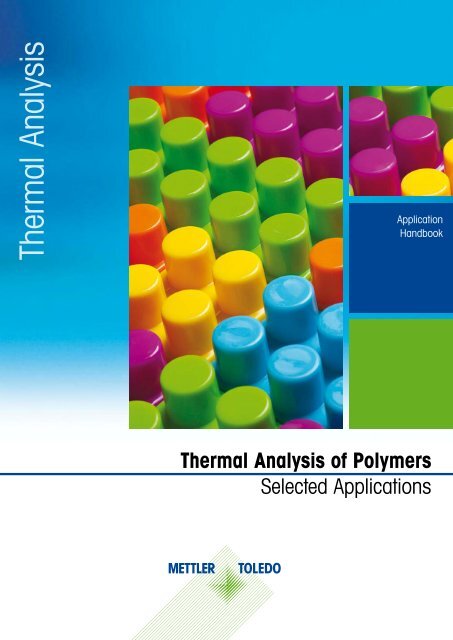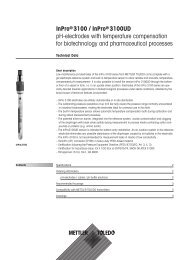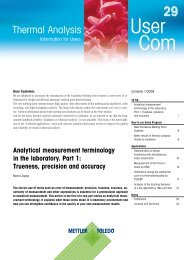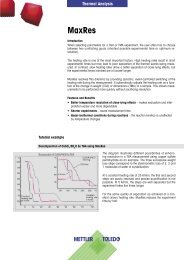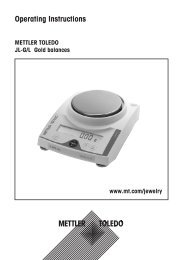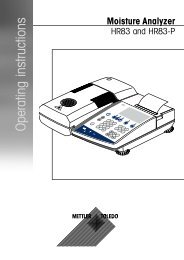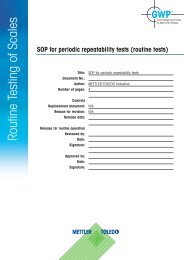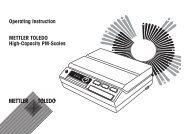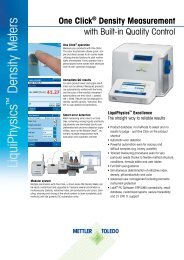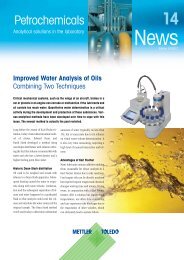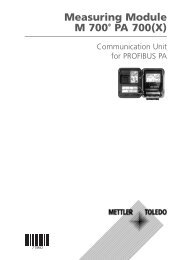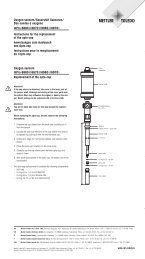Thermal Analysis of Polymers - Mettler Toledo
Thermal Analysis of Polymers - Mettler Toledo
Thermal Analysis of Polymers - Mettler Toledo
- No tags were found...
You also want an ePaper? Increase the reach of your titles
YUMPU automatically turns print PDFs into web optimized ePapers that Google loves.
temperatures that characterize a thermaleffect, measure deformation step heights,and to determine expansion coefficients.1.9 DMADynamic Mechanical <strong>Analysis</strong>In DMA, the sample is subjected to a sinusoidalmechanical stress. The forceamplitude, displacement (deformation)amplitude, and phase shift aredetermined as a funtion <strong>of</strong> temperatureor frequency. DMA allows you to detectthermal effects based on changes in themodulus or damping behavior.The most important results are temperaturesthat characterize a thermal effect,the loss angle (the phase shift), the mechanicalloss factor (the tangent <strong>of</strong> thephase shift), the elastic modulus or itscomponents the storage and loss moduli,and the shear modulus or its componentsthe storage and loss moduli.1.10 TOAThermo-optical <strong>Analysis</strong>By TOA we mean the visual observation<strong>of</strong> a sample using transmitted or reflectedlight, or the measurement <strong>of</strong> its opticaltransmission by means <strong>of</strong> hot-stagemicroscopy or DSC microscopy. Typicalapplications are the investigation <strong>of</strong> crystallizationand melting processes andpolymorphic transitions.1.11 TCLThermochemiluminescenceTCL is a technique that allows you to observeand measure the weak light emissionthat accompanies certain chemicalreactions.1.12 Application OverviewProperty or application DSC DTA TGA TMA DMA TOA TCL EGASpecific heat capacity ••• •Enthalpy changes, enthalpy <strong>of</strong> conversion ••• •Enthalpy <strong>of</strong> melting, crystallinity ••• •Melting point, melting behavior (liquid fraction) ••• • • •••Purity <strong>of</strong> crystalline non-polymeric substances ••• ••• •Crystallization behavior, supercooling ••• • •••Vaporization, sublimation, desorption ••• • ••• ••• •••Solid–solid transitions, polymorphism ••• ••• • •••Glass transition, amorphous s<strong>of</strong>tening ••• • ••• ••• •<strong>Thermal</strong> decomposition, pyrolysis, depolymerization, • • ••• • • •••and degradationTemperature stability • • ••• • • •••Chemical reactions, e.g. polymerization ••• • • •Investigation <strong>of</strong> reaction kinetics and applied kinetics ••• • ••• •(predictions)Oxidative degradation, oxidation stability ••• ••• ••• • •••Compositional analysis ••• ••• •••Comparison <strong>of</strong> different lots and batches, competitiveproductsLinear expansion coefficient••• • ••• • • ••• • •••Elastic modulus • •••Shear modulusMechanical dampingViscoelastic behavior • •••••• means “very suitable”, • means “less suitable”•••••••••Table 1.Application overviewshowing thethermal analysistechniques that canbe used to studyparticular propertiesor perform certainapplications.METTLER TOLEDO Selected Applications<strong>Thermal</strong> <strong>Analysis</strong> <strong>of</strong> <strong>Polymers</strong>9
2. DSC <strong>Analysis</strong> <strong>of</strong> ThermoplasticsThermoplasticsFigure 2.Structural formula<strong>of</strong> PET.Figure 3.The main effectsmeasured by DSCusing PET as asample. Temperaturerange30–300 °C; heatingrate 20 K/min;purge gas nitrogenat 50 mL/min.2.1 IntroductionThis chapter describes how DSC is used toanalyze a thermoplastic, PET (polyethyleneterephthalate), as comprehensivelyas possible [1]. The results <strong>of</strong> the variousmethods are compared with one another.The main topics discussed are:• Glass transition• Cold crystallization• Recrystallization• Melting• <strong>Thermal</strong> history• Oxidation induction time• Decomposition.PETPET was chosen to represent the group <strong>of</strong>thermoplastic polymers. It is a polyesterproduced in a polycondensation reactionbetween terephthalic acid and ethyleneglycol. Its structure is shown in Figure 2.PET is used for many different applications.One <strong>of</strong> the most well known is themanufacture <strong>of</strong> plastic bottles in the beverageindustry. It is also used as a fiber inthe sports clothing industry because <strong>of</strong> itsexcellent crease-, tear- and weather-resistanceproperties and low water absorption.Films <strong>of</strong> 1 to 500 µm are used for packagingmaterials, for the manufacture <strong>of</strong>furniture, sunshades, and so on. The finishedfilms are <strong>of</strong>ten coated or laminatedwith other films and are widely used inthe food industry, for example for packagingc<strong>of</strong>fee or other foodstuffs to preventthe loss <strong>of</strong> aroma. The characterization<strong>of</strong> the properties <strong>of</strong> the material is thereforevery important in order to guaranteeconstant quality.2.2 Experimental detailsThe DSC measurements described in thischapter were performed using a DSC 1equipped with an FRS5 sensor and evaluatedwith the STAR e s<strong>of</strong>tware. PET samplesweighing about 3 to 10 mg were preparedand pretreated depending on theapplication. In general, samples shouldhave a flat surface and make good contactwith the crucible. The bottom <strong>of</strong> thecrucible should not be deformed by thesample material when it is sealed.2.3 Measurements and resultsDifferential scanning calorimetryDSC is a technique that measures theheat flow <strong>of</strong> samples as a function <strong>of</strong>temperature or time. The method allowsphysical transitions and chemical reactionsto be quantitatively measured [2].Effects <strong>of</strong> this type were analyzed withthe aid <strong>of</strong> different DSC measurements.Figure 3 shows the most important eventsthat occur when PET is measured byDSC. These are <strong>of</strong>ten characteristic fora substance and serve as a fingerprint,enabling them to be used for qualitycontrol.Figure 3 displays a typical first heatingmeasurement curve <strong>of</strong> a PET sample. Itshows the glass transition, cold crystallization,and melting. The glass transitionexhibits enthalpy relaxation, whichis shown by the overlapping endothermicpeak. The latter occurs when the samplehas been stored for a long time at a temperaturebelow the glass transition.Cold crystallization takes place when thesample is cooled rapidly and has no timeto crystallize during the cooling phase.The DSC curve can also be used to determinethe specific heat capacity, c p .Different standard procedures exist forthe determination <strong>of</strong> the glass transitiontemperature; several <strong>of</strong> theses are evaluateddirectly by the STAR e s<strong>of</strong>tware andare shown in Figure 3.Glass transitionThe glass transition is a reversible transitionthat occurs when an amorphousmaterial is heated or cooled in a particulartemperature range. It is characterizedby the glass transition temperature, T g .On cooling, the material becomes brittle(less flexible) like a glass, and on heatingbecomes s<strong>of</strong>t [2, 3, 4, 5]. In the case<strong>of</strong> thermoplastics, the glass transitioncorrelates with the region above whichthe material can be molded. The glasstransition is exhibited by semicrystallineor completely amorphous solids as wellas by ordinary glasses and plastics (organicpolymers).Above the glass transition, glasses or organicpolymers become s<strong>of</strong>t and can be10 <strong>Thermal</strong> <strong>Analysis</strong> <strong>of</strong> <strong>Polymers</strong> METTLER TOLEDO Selected Applications
plastically deformed or molded withoutbreaking. This behavior is one <strong>of</strong> theproperties that makes plastics so useful.The glass transition is a kinetic phenomenon;the measured value <strong>of</strong> the glasstransition depends on the cooling rate,the thermomechanical history <strong>of</strong> thesample and the evaluation conditions.The lower the cooling rate, the lower theresulting glass transition that is measuredin the following heating run. Thismeans that the glass transition temperaturedepends on the measurement conditionsand cannot be precisely defined.In many cases, an enthalpy relaxationpeak is observed that overlaps the glasstransition. This depends on the history <strong>of</strong>the sample. Physical aging below the glasstransition leads to enthalpy relaxation.At the glass transition temperature, T g ,the following physical properties change:• Specific heat capacity (c p )• Coefficient <strong>of</strong> <strong>Thermal</strong> Expansion,CTE, (can be measured by TMA)• Mechanical modulus (can be measuredby DMA)• Dielectric constantThe 2/3 rule can be used as a rule <strong>of</strong>thumb. This states that the glass transitiontemperature corresponds to 2/3 <strong>of</strong> themelting point temperature (in Kelvin):• For PET: T melt is 256 °C or 529.16 K• T g ~ 352.8 K or 79.6 °CMeltingMelting is the transition from the solid tothe liquid state. It is an endothermic processand occurs at a defined temperaturefor pure substances. The temperatureremains constant during the transition:The heat supplied is required to bringabout the change <strong>of</strong> state and is knownas the latent heat <strong>of</strong> melting.CrystallinityThe degree <strong>of</strong> crystallinity is the percentagecrystalline content <strong>of</strong> a semicrystallinesubstance. Thermoplastics normallyexhibit a degree <strong>of</strong> crystallinity <strong>of</strong> up to80%. The degree <strong>of</strong> crystallinity <strong>of</strong> a materialdepends on its thermal history. Itcan be determined by measuring the enthalpy<strong>of</strong> fusion <strong>of</strong> the sample and dividingthis by the enthalpy <strong>of</strong> fusion <strong>of</strong> the100% crystalline material. 100% crystallinematerials can be determined X-raydiffraction.Semicrystalline samples such as PETundergo cold crystallization above theirglass transition. This makes it difficultto determine their degree <strong>of</strong> crystallinitybefore the measurement. This particulartopic will therefore not be further discussedin this chapter.RecrystallizationRecrystallization is a type <strong>of</strong> reorganizationprocess in which larger crystallitesare formed from smaller crystallites. Theprocess is heating-rate dependent: thelower the heating rate, the more timethere is for reorganization. Recrystallizationis difficult to detect by DSC becauseexothermic crystallization and endothermicmelting occur simultaneously.Heating-Cooling-HeatingFigure 4 shows a measurement in whicha sample was heated, cooled, and thenheated again at 20 K/min. This type <strong>of</strong>experiment is <strong>of</strong>ten performed to thermallypretreat the sample in a definedway in the first heating run. In Figure 4,the first heating run corresponds to thecurve shown in Figure 3.The figure also shows that the secondheating run is very different to the firstrun – the melting peak is broader and therelaxation at the glass transition and thecold crystallization are no longer present.During cooling the sample had sufficienttime for crystallization to occur.The crystallization peak is clearly visiblein the cooling curve. Since the samplewas heated immediately afterward, noenthalpy relaxation occurs because it hadno time to undergo physical aging.In practice, heating-cooling-heating experimentsare used to eliminate the thermalhistory <strong>of</strong> material and to check theproduction process <strong>of</strong> a sample. In thesecond heating run, the glass transitionstep is smaller. This means that the content<strong>of</strong> amorphous material is lower andthe crystalline content larger than in theThe glass transition appears as a step inthe DSC curve and shows the change <strong>of</strong>the specific heat capacity, c p , from thesolid to the liquid phase.Cold crystallizationCold crystallization is an exothermiccrystallization process. It is observedon heating a sample that has previouslybeen cooled very quickly and has had notime to crystallize. Below the glass transition,molecular mobility is severely restrictedand cold crystallization does notoccur; above the glass transition, smallcrystallites are formed at relatively lowtemperatures. The process is called coldcrystallization.Figure 4.First and secondheating runs andthe cooling curvedemonstrate differencesregardingrelaxation at theglass transition andthe disappearance<strong>of</strong> cold crystallization.METTLER TOLEDO Selected Applications<strong>Thermal</strong> <strong>Analysis</strong> <strong>of</strong> <strong>Polymers</strong>11
the heating rate, the less time there is forcrystallization. At 300 K/min, the samplehas no time to crystallize and consequentlyshows no melting peak.TOPEM ®TOPEM ® is the newest and most powerfultemperature-modulation techniqueused in DSC alongside IsoStep and ADSC.It allows reversing and non-reversingeffects to be separated from each other.Figure 9 shows the results obtained froma TOPEM ® measurement <strong>of</strong> PET usingstandard parameters. The sample waspreheated to 80 °C and shock cooledby removing the crucible from the furnaceand placing it on a cold aluminumplate. The TOPEM ® experiment was performedin a 40-µL aluminum cruciblewith a hole in the lid at a heating rate <strong>of</strong>0.2 K/min.The uppermost curve in Figure 9 showsthe measurement data before evaluation.The TOPEM ® evaluation yields separatecurves for the total heat flow (black),reversing heat flow curve (red) and thenon-reversing heat flow curve (blue).In addition, the quasi-static c po can becalculated from the measurement. In asecond step, the heat capacity or phasecan be determined at user-defined frequencies.In Figure 9, this is done at afrequency <strong>of</strong> 16.7 Hz. TOPEM ® [8, 9] isalso an excellent technique to determinec p and to separate effects that cannot beseparated by DSC. For example, it canseparate the enthalpy change associatedwith a glass transition from the enthalpyproduced in a reaction that occurs simultaneously– a glass transition is areversing effect while a reaction is a nonreversingeffect.Figure 7.Heating runs showingthe influence <strong>of</strong>different annealingtimes on the glasstransition and theenthalpy relaxationpeak <strong>of</strong> PET.Figure 8.DSC measurements<strong>of</strong> PET at high heatingrates, shown asc p curves.Figure 9.Measurement <strong>of</strong> aPET sample usingTOPEM ® showingthe reversing, nonreversingand totalheat flow curves.The TOPEM ® technique uses a stochastictemperature pr<strong>of</strong>ile. This allows thesample to be characterized from the results<strong>of</strong> just one single measurement. Thecurves in Figure 10 show the frequencydependence <strong>of</strong> the glass transition <strong>of</strong> asample <strong>of</strong> PET. In this case, the glasstransition shifts to higher temperature athigher frequencies. In contrast, the stepin the curve due to cold crystallizationoccurs at the same temperature and isMETTLER TOLEDO Selected Applications<strong>Thermal</strong> <strong>Analysis</strong> <strong>of</strong> <strong>Polymers</strong>13
ThermoplasticsFigure 10.Measurement <strong>of</strong> aPET sample usingTOPEM ® showingthe frequencydependence <strong>of</strong> theglass transition.independent <strong>of</strong> frequency. The frequencydependence <strong>of</strong> certain effects shown byunknown substances can thus be studiedin order to clarify the interpretation <strong>of</strong>their origin.Oxidative stability (OIT/OOT)Finally, we would like to briefly explaintwo DSC methods known as OIT andOOT that are used to measure the oxidativestability [10, 11] <strong>of</strong> polymers andoils. The methods simulate the acceleratedchemical aging` <strong>of</strong> products andallow information to be obtained abouttheir relative stability. For example, differentmaterials can be compared withone another or samples <strong>of</strong> the same materialcontaining different additives canbe analyzed to determine the influence<strong>of</strong> an additive. In practice, the methodis widely used for PE (polyethylene). Theapplication example described below alsouses a sample <strong>of</strong> PE because the decomposition<strong>of</strong> PET is overlapped by meltingand re-esterification and cannot beclearly identified.The OIT (Oxidation Induction Time)measurement <strong>of</strong> PE (Figure 11) is <strong>of</strong>tenperformed in crucibles made <strong>of</strong> differentmetals in order to determine theinfluence <strong>of</strong> the particular metal on thestability <strong>of</strong> the PE. In this example, themeasurement was started in a nitrogenatmosphere according to the followingtemperature program: 3 min at 30 °C,heating at 20 K/min from 30 to 180 °C,then isothermal at 180 °C. After 2 minthe gas was switched to oxygen. Themeasurement was stopped as soon asoxidation was observed. The OIT is thetime interval from when the purge gasis switched to oxygen to the onset <strong>of</strong> oxidation.Measurements were performed inopen 40-µL aluminum and copper cruciblesfor comparison. Oxidation clearlytakes place much earlier in the coppercrucible than in the aluminum crucible.The copper acts as a catalyst and acceleratesthe decomposition <strong>of</strong> PE.The oxidative stability <strong>of</strong> samples canalso be compared by measuring the OnsetOxidation Temperature (OOT). Inthis method, the sample is heated in anoxygen atmosphere and the onset temperatureat which oxidation begins isevaluated.Since OIT measurements are easy to performand do not take much time, theyare <strong>of</strong>ten used in quality control to comparethe stability <strong>of</strong> products.Figure 11.OIT measurements<strong>of</strong> PE in differentcrucibles.2.4 References[1] Total <strong>Analysis</strong> with DSC, TMA andTGA-EGA, UserCom 9, 8–12.[2] Interpreting DSC curves,Part 1: Dynamic measurements,UserCom 11, 1–7.[3] The glass transition from the point<strong>of</strong> view <strong>of</strong> DSC-measurements; Part1: Basic principles, UserCom 10,13–16.[4] The glass transition temperaturemeasured by different TA techniques,Part 1: Overview, UserCom 17, 1–4.[5] R. Riesen, The glass transitiontemperature measured by differentTA technique, Part 2: Determination<strong>of</strong> glass transition temperatures,UserCom 18, 1–5.[6] M. Wagner, DSC Measurements athigh heating rates – advantages andlimitations, UserCom 19, 1–5.[7] R. Riesen, Influence <strong>of</strong> the heatingrate: Melting and chemical reactions,UserCom 23, 20–22.[8] TOPEM ® – The new multi-frequencytemperature-modulated technique,UserCom 22, 6–8.[9] J. Schawe, <strong>Analysis</strong> <strong>of</strong> meltingprocesses using TOPEM ®UserCom 25, 13–17.[10] Oxidative stability <strong>of</strong> petroleum oilfractions, UserCom 10, 7–8.[11] A. Hammer, The characterization <strong>of</strong>olive oils by DSC, UserCom 28, 6–8.14 <strong>Thermal</strong> <strong>Analysis</strong> <strong>of</strong> <strong>Polymers</strong> METTLER TOLEDO Selected Applications
3. TGA, TMA and DMA <strong>Analysis</strong> <strong>of</strong> Thermoplastics3.1 IntroductionThis chapter focuses on the use <strong>of</strong> TGA,TMA and DMA techniques. Effects suchas decomposition, expansion, cold crystallization,glass transition, melting,relaxation and recrystallization arediscussed in detail. TGA, TMA and DMAyield valuable complementary informationto DSC measurements.3.2 Thermogravimetricanalysis (TGA)Thermogravimetric analysis is a techniquethat measures the mass <strong>of</strong> a samplewhile it is heated, cooled or held isothermallyin a defined atmosphere. It ismainly used for the quantitative analysis<strong>of</strong> products.A typical TGA curve shows the mass losssteps relating to the loss <strong>of</strong> volatile components(moisture, solvents, monomers),polymer decomposition, combustion <strong>of</strong>carbon black, and final residues (ash,filler, glass fibers). The method allows usto study the decomposition <strong>of</strong> productsand materials and to draw conclusionsabout their individual constituents.corrected for the mass lost by the sampleduring the measurement (left); the bluecurve is the uncorrected curve and thered curve is corrected for the loss <strong>of</strong> mass[2, 3].DecompositionIn a decomposition process, chemicalbonds break and complex organic compoundsor polymers decompose to formgaseous products such as water, carbondioxide or hydrocarbons.Under non-oxidizing (inert) conditions,organic molecules may also degrade withthe formation <strong>of</strong> carbon black. Volatiledecomposition products can be identifiedby connecting the TGA to a Fourier transforminfrared spectrometer (FTIR) or amass spectrometer (MS).3.3 Thermomechanicalanalysis (TMA)Thermomechanical analysis measuresthe dimensional changes <strong>of</strong> a sampleas it is heated or cooled in a definedatmosphere. A typical TMA curve showsexpansion below the glass transitiontemperature, the glass transition (seenas a change in the slope <strong>of</strong> the curve),Figure 12.Measurementcurves <strong>of</strong> PET recordedfrom 30 to1000 °C at a heatingrate <strong>of</strong> 20 K/minusing a TGA/DSC 1equipped with aDSC sensor. TheTGA curve showsthe change in mass<strong>of</strong> the sample andthe DSC curve theendothermic or exothermiceffects.The first derivative <strong>of</strong> the TGA curve withrespect to time is known as the DTGcurve; it is proportional to the rate <strong>of</strong> decomposition<strong>of</strong> the sample. In a TGA/DSCmeasurement, DSC signals and weightinformation are recorded simultaneously.This allows endothermic or exothermiceffects to be detected and evaluated.Figure 13.TMA measurement<strong>of</strong> PET in the dilatometrymode.The DSC signal recorded in TGA/DSCmeasurement is, however, less sensitivethan that obtained from a dedicated DSCinstrument and the DSC curves are lesswell resolved.The upper diagram <strong>of</strong> Figure 12 showsTGA and DTG curves <strong>of</strong> PET. The twolower diagrams are the correspondingDSC curves measured in a nitrogenatmosphere. The DSC curve on the rightin the range up to 300 °C shows the glasstransition, cold crystallization, and themelting process. The DSC signal can beMETTLER TOLEDO Selected Applications<strong>Thermal</strong> <strong>Analysis</strong> <strong>of</strong> <strong>Polymers</strong>15
ThermoplasticsFigure 14.TMA <strong>of</strong> PET measuredin the penetrationmode.expansion above the glass transitiontemperature and plastic deformation.Measurements can be performed in thedilatometry mode, the penetration mode,or the DLTMA (Dynamic Load TMA)mode.DilatometryThe aim <strong>of</strong> dilatometry is to measure theexpansion or shrinkage <strong>of</strong> a sample. Forthis reason, the force used is very low andis just sufficient to ensure that the proberemains in contact with the sample. Theresult <strong>of</strong> the measurement is the coefficient<strong>of</strong> thermal expansion (CTE). Thedilatometry measurement shown in Figure13 was performed using a sampleabout 0.5 mm thick sandwiched betweentwo silica disks. It was first preheatedin the instrument to 90 °C to eliminateits thermal history. After cooling, it wasmeasured in the range 30 to 310 °C ata heating rate <strong>of</strong> 20 K/min using theball-point probe and a very low force <strong>of</strong>0.005 N.The curve in the upper diagram <strong>of</strong>Figure 13 shows that the sample expandsonly slowly up to the glass transition.The expansion rate then increases significantlyon further heating due to theincreased mobility <strong>of</strong> the molecules inthe liquid state. Afterward, cold crystallizationand recrystallization processes occurand the sample shrinks. The sampleexpands again after crystallite formationabove about 150 °C and finally melts.The melting is accompanied by a drasticdecrease in viscosity and sample height.PenetrationPenetration measurements mainly yieldinformation about temperatures. Thethickness <strong>of</strong> the sample is not usuallyimportant because the contact area <strong>of</strong>the probe with the sample changes duringthe experiment. The depth <strong>of</strong> penetrationis influenced by the force usedfor the measurement and the samplegeometry.For the penetration measurement, a sampleabout 0.5 mm thick was placed on asilica disk; the ball-point probe resteddirectly on the sample. The measurementswere performed in the range 30 to300 °C at a heating rate <strong>of</strong> 20 K/min usingforces <strong>of</strong> 0.1 and 0.5 N. In this case,the sample was not preheated.During the penetration measurement,the probe penetrates more and more intothe sample. The ordinate signal decreasessignificantly at the glass transition,remains more or less constant after coldcrystallization, and then decreases againon melting (Figure 14).Figure 15.DLTMA measurement<strong>of</strong> PET fromroom temperatureto 160 °C.DLTMADLTMA is a very sensitive method fordetermining physical properties. In contrastto DSC, it characterizes the mechanicalbehavior <strong>of</strong> samples. In DLTMA(Dynamic Load TMA) [4], a high and alow force alternately act on the sampleat a given frequency. This allows weaktransitions, expansion, and the elasticity(Young’s modulus) <strong>of</strong> samples to bemeasured. The larger the stiffness <strong>of</strong> thesample, the smaller the amplitude.The measurement curve in Figure 15shows the glass transition at 72 °C followedby the expansion <strong>of</strong> the materialin the liquid state; the amplitude is largebecause the material is s<strong>of</strong>t. This is followedby cold crystallization; the PETshrinks and the amplitude becomessmaller. At 140 °C, the sample is onceagain hard. The sample then expands onfurther temperature increase to 160 °C.16 <strong>Thermal</strong> <strong>Analysis</strong> <strong>of</strong> <strong>Polymers</strong> METTLER TOLEDO Selected Applications
3.4 Dynamicmechanical analysis (DMA)Dynamic mechanical analysis measuresthe mechanical properties <strong>of</strong> a viscoelasticmaterial as a function <strong>of</strong> time,temper ature or frequency while thematerial is subjected to a periodically oscillatingforce.In a typical measurement, an oscillatingforce is applied to the sample at differentfrequencies. The elastic modulus is measuredas the shear storage modulus, G',and loss modulus, G". This data is usedto calculate tan delta, the loss factor, orthe damping coefficient, G"/G'. DMA ismuch more sensitive than other methods.For example, it can measure glass transitions<strong>of</strong> filled materials or thin layerson substrate material, that is, transitionswhich are difficult to detect by DSC.Figure 16 displays the DMA measurementcurve <strong>of</strong> a shock-cooled PET sample 5 mmin diameter and 0.49 mm thick in theshear mode at 1 Hz in the range –150 °Cto +270 °C. The heating rate was 2 K/min.Figure 16.DMA shear measurement<strong>of</strong> PET inthe range –150 °Cto +270 °C.Figure 17.Overview <strong>of</strong> the effectsand comparison<strong>of</strong> the results.The DMA curve also shows other effectssuch as relaxation (local movement <strong>of</strong>polymer groups) or recrystallization inaddition to the effects detected by TMAor TGA/DSC such as the glass transition,crystallization and melting. relaxationis weak and can only be measured byDMA. Other thermal analysis techniquessuch as DSC or TGA cannot detect thistransition.3.5 Overview <strong>of</strong> the effectsand comparison <strong>of</strong> the resultsFigure 17 presents an overview <strong>of</strong> the differentthermal methods used to analyze PET.Table 2 summarizes the effects that can bemeasured by different thermal methods.Table 3 compares the results obtained forPET using the various techniques. Thetemperatures given for TGA/DSC andDSC refer to peak temperatures, the TMAtemperatures to the beginning <strong>of</strong> thechange in expansion, and the DMA temperaturesto the peaks in the tan deltacurve.It is evident that the different methodsyield consistent results, complement oneanother other and provide important informationfor the characterization <strong>of</strong> materialproperties. This is particularly usefulfor the quality control <strong>of</strong> substances,for the examination <strong>of</strong> unknown materialsor for damage and failure analysis,Effects DSC TGA/DSC TMA DMA relaxationxGlass transition x x (DSC signal) x xCold crystallization x x (DSC signal) x xRecrystallization (x) xMelting x x x xDecomposition (x) x (x)OITxTable 2.Effects measured bydifferent analyticalmethods.METTLER TOLEDO Selected Applications<strong>Thermal</strong> <strong>Analysis</strong> <strong>of</strong> <strong>Polymers</strong>17
ThermosetsFigure 20.KU600: DSC experimentshowing theeffect <strong>of</strong> differentcooling rates on theglass transition.followed by a large exothermic reactionpeak that characterizes the curing <strong>of</strong> theepoxy resin. A small endothermic peakcan be seen at about 210 °C in the middle<strong>of</strong> the exothermic curing peak. This iscaused by the melting <strong>of</strong> an additive (dicyandiamide)in the KU600.The third heating run looks completelydifferent. The material has obviously undergonea drastic change. Initially, thesample was present as a powder.This coalesced and cured during the secondheating run to form a solid crosslinkedmaterial that exhibits differentproperties. In particular, the third heatingrun shows that the glass transition hasshifted to higher temperature and that n<strong>of</strong>urther exothermic reaction occurs.Figure 19 summarizes the results obtainedwhen KU600 was stored isothermallyfor different times at 150 °C andthen measured in dynamic DSC experiments.In each case, first and secondheating runs were performed. The resultsshow that the glass transition temperatureclearly depends on the degree <strong>of</strong>cure. The higher the degree <strong>of</strong> cure, themore the glass transition shifts to highertemperature. The first heating run alsoshows that the area <strong>of</strong> the postcuring reactionpeak decreases with increasing degree<strong>of</strong> cure. Completely cured materialshows no postcuring at all [4].<strong>Thermal</strong> historyFigure 20 shows the effect <strong>of</strong> differentcooling rates on the glass transition.Cured KU600 was first cooled at differentrates and the effect on the glass transitionmeasured in subsequent heatingruns at 10 K/min. Low cooling rates havethe same effect as long annealing timesbelow the glass transition temperature.The lower the cooling rate, the larger theenthalpy relaxation effect. The enthalpyrelaxation can therefore be used to checkwhether the process or storage conditionsremain the same.Isothermal and dynamic curingFigure 21 shows the isothermal DSCcurves and calculated conversion curvesfor the curing <strong>of</strong> KU600. The higherthe curing temperature, the shorter thecuring time. In this example, samples<strong>of</strong> KU600 at room temperature were insertedinto a preheated instrument at 180and 190 °C. The upper diagram showsthe two isothermal curing curves and thelower diagram the corresponding conversioncurves. The latter indicate the timetaken to reach a particular conversion.For example, a degree <strong>of</strong> cure <strong>of</strong> 80%takes about 10.8 min at 180 °C andabout 6 min at 190 °C. To achieve completecuring or 100% cured material, theisothermal curing temperature must begreater than the glass transition temperature<strong>of</strong> the fully cured material.Figure 21.KU600: Isothermallycured at 180and 190 °C.Above: the DSCcurves. Below: thecalculated conversioncurves.Dynamic curing is another possible approach.In Figure 22 (1, above left) theKU600 was measured dynamically atdifferent heating rates. The results showthat the glass transition with the enthalpyrelaxation peak and the curingreaction shift to higher temperature athigher heating rates, while the smallmelting peak always appears at the sametemperature.KineticsChemical kinetics, also called reactionkinetics, is a method used to study therate at which a chemical process proceeds.The most important application <strong>of</strong>kinetics in thermal analysis is to predictreaction behavior under conditions in20 <strong>Thermal</strong> <strong>Analysis</strong> <strong>of</strong> <strong>Polymers</strong> METTLER TOLEDO Selected Applications
ThermosetsFigure 27.DLTMA measurement<strong>of</strong> a curedKU600 coating.expansion coefficients are bonded together,there is always the risk that thecomposite might fracture on temperaturechange. Measurements <strong>of</strong> cured KU600powder show how the expansion coefficientis determined.A 1.9-mm thick sample was placed betweentwo thin quartz disks and positionedon the TMA sample holder. The3-mm ball-point probe used for themeasurement rested on the upper disk.This ensured that the force exerted by theprobe was uniformly distributed over theentire surface <strong>of</strong> the sample.A low force <strong>of</strong> 0.02 N was used. This wassufficient to maintain good contact betweenthe probe and the sample withoutdeforming the sample. The sample wasfirst measured from 40 to 160 °C. Thisalso eliminated any relaxation effects.After cooling, a second heating run wasperformed and used for the evaluation.Figure 26 shows the results obtainedfrom the second heating run. The blackcurve is the measurement curve; the blueinserted diagram shows the temperaturedependentexpansion coefficient. Expansion<strong>of</strong> the sample is noticeably greaterafter the glass transition at about 100 °C.A mean expansion coefficient was evaluatedfrom the TMA curve in the range 50to 150 °C using the “Type mean” function.The expansion coefficient at 140 °Cwas also determined from the slope <strong>of</strong>the TMA curve using the “Type instant”function.DLTMA for the determination<strong>of</strong> T g and Young’s modulusDLTMA (Dynamic Load TMA), [3] can beused to measure the glass transition <strong>of</strong>a thin coating <strong>of</strong> a cured sample and atthe same time determine the change inYoung’s modulus. The sample was a coatingon a metal sheet.The measurement was performed in staticair from 50 to 240 °C at a heating rate<strong>of</strong> 5 K/min in the 3-point bending modeusing a 3-mm ball-point probe. The forcealternated between 0.1 and 1 N. The periodwas 12 s, that is, the force changedevery 6 s. The results are presented inFigure 27.The top curve shows the initial measurementcurve. Below the glass transition,the amplitude is small, only about40 μm; above the glass transition, theamplitude however increases to 200 μm.Figure 28.TMA measurement<strong>of</strong> a thin coating <strong>of</strong>cured KU600 to determinethe s<strong>of</strong>teningtemperature.The onset evaluated for the mean curve(top curve, red) is a characteristic temperature.The amplitude <strong>of</strong> the DLTMAcurve is a measure <strong>of</strong> the elasticity orthe Young’s modulus <strong>of</strong> the sample. Themodulus curve can also be used to determinethe glass transition as shownin the middle curve. The bottom curvedisplays tan delta; the peak temperatureis also used as a value for the glasstransition.Determination <strong>of</strong> the s<strong>of</strong>teningtemperature <strong>of</strong> a thin coatingThe measurement shows the determination<strong>of</strong> the s<strong>of</strong>tening temperature <strong>of</strong>a thin coating <strong>of</strong> cured KU600 with athickness <strong>of</strong> 27 µm. The measurementwas performed in static air from 40 to190 °C at a heating rate <strong>of</strong> 5 K/min usinga 3-mm ball-point probe and a force <strong>of</strong>1 N. The probe was in direct contact withthe sample.Figure 28 shows the resulting TMA curvewith the s<strong>of</strong>tening temperature (T g ).The expansion before and after penetra-24 <strong>Thermal</strong> <strong>Analysis</strong> <strong>of</strong> <strong>Polymers</strong> METTLER TOLEDO Selected Applications
tion <strong>of</strong> the probe into the coating (i.e.at the glass transition) corresponds tothe expansion <strong>of</strong> the aluminum substrate;the coating itself makes almost nocontribution.The inflection, endpoint and midpointare important characteristic temperaturesin addition to the onset. The exampleshows that a very thin coating is idealfor determining the s<strong>of</strong>tening temperature.Special sample preparation is notnecessary. The glass transition is measureddirectly in the first heating run.5.4 Dynamic mechanicalanalysis (DMA)As described in reference [4], dynamicmechanical analysis (DMA) is used todetermine the mechanical properties<strong>of</strong> viscoelastic materials as a function<strong>of</strong> time, temperature or frequency. Themeasurement is performed by applying aperiodic oscillating force to the material.The following section describes the evaluation<strong>of</strong> the glass transition and its frequencydependence [5, 6].mic. In both cases, the glass transitionis at about 110 °C. The storage modulusdecreases with increasing temperatureand the loss modulus and tan delta exhibita peak. Two methods are used to determinethe onset.The linear presentation shows the evaluationaccording to DIN 65583, the so-called2% method, and the diagram on the rightwith the logarithmic ordinate, the ASTME6140 evaluation.Each method yields different results for T g .For this reason, it is important to quotethe measurement conditions and evaluationprocedures when evaluating andcomparing glass transition tem-peratures.Comparison <strong>of</strong> the two diagrams showsthat the differences between the storageand loss moduli are clearer in the logarithmicpresentation. The logarithmiccurve presentation is therefore usuallyrecommended to make it easier to detectthe different effects.Frequency dependence<strong>of</strong> the glass transitionFigure 30 shows a DMA experiment inwhich different frequencies were simultaneouslyapplied. The sample preparationwas the same as for the measurementsin Figure 29. The cured samplewas measured from 70 to 180 °C usinga maximum force amplitude <strong>of</strong> 5 N anda maximum displacement amplitude <strong>of</strong>Figure 29.DMA measurement<strong>of</strong> KU600 from 90to 160 °C, in linearand logarithmic ordinatepresentation.Determination <strong>of</strong>the glass transitionFigure 29 shows a DMA measurement <strong>of</strong>cured KU600 in the shear mode. Two diskswith a diameter <strong>of</strong> 5 mm and thickness <strong>of</strong>0.56 mm were prepared by pressing KU600powder in a suitable die.The disks were loaded in the shear sampleholder, heated to 250 °C at a heating rate<strong>of</strong> 2 K/min and then cooled at the samerate. They were then measured at 2 K/minin the range 40 to 160 °C at a frequency <strong>of</strong>1 Hz using a maximum force amplitude <strong>of</strong>5 N and a maximum displacement amplitude<strong>of</strong> 20 μm.Figure 30.DMA measurement<strong>of</strong> KU600 at differentfrequencies todemonstrate thefrequency dependence<strong>of</strong> the glasstransition.Figure 29 shows measurement curvesfrom the second heating run and in particularthe storage modulus (G´), the lossmodulus (G˝) and tan delta <strong>of</strong> the curedmaterial. Here, the focus is on the presentation<strong>of</strong> the ordinate and the evaluation<strong>of</strong> the glass transition.In the diagram on the left, the ordinatescale is linear and on the right, logarith-METTLER TOLEDO Selected Applications<strong>Thermal</strong> <strong>Analysis</strong> <strong>of</strong> <strong>Polymers</strong>25
Elastomers30 μm. The frequency range was between0.1 and 1000 Hz.The upper diagram displays the storageand loss moduli and the lower diagramtan delta as a function <strong>of</strong> time in a logarithmicordinate presentation. The storagemoduli show a step in the glass transitionwhereas the loss moduli and tandelta display a peak. The tan delta peaksare always at a somewhat higher temperaturecompared with the correspondingpeaks <strong>of</strong> the loss modulus.higher temperatures. The reason for thisis that the glass transition is a relaxationeffect. This phenomena is discussed inmore detail in reference [7].5.5 Overview <strong>of</strong> effectsand comparison <strong>of</strong> resultsFigure 31 presents an overview <strong>of</strong> thethermal analysis methods used to investigateKU600. It shows quite clearly thatthe different techniques yield similar valuesfor the glass transition (see red linein Figure 31).available for characterizing a thermoset(KU600) using DSC, TGA, TMA, and DMAtechniques. The various methods yieldconsistent results.The main effects investigated were theglass transition, the curing reaction,expansion, decomposition. Furthermore,the application <strong>of</strong> model free kinetics wasdiscussed and the frequency dependence<strong>of</strong> the glass transition shown using DMAmeasurements. Other thermosets showsimilar effects.Figure 31.Overview <strong>of</strong> the effectsand comparison<strong>of</strong> results.The results clearly show that the glasstransition depends on the frequency andthat it is shifted to higher frequencies at5.6 ConclusionsThis chapter and the previous chapter[1] discussed the different possibilitiesA particular effect can <strong>of</strong>ten be measuredby different thermal analysis techniques.The results obtained from one technique<strong>of</strong>ten provide complementary informationand confirm the results from anothertechnique. Ideally, a material is firstanalyzed by TGA, then by DSC and TMA,and finally by DMA.5.7 References[1] A. Hammer, <strong>Thermal</strong> analysis <strong>of</strong> polymers,Part 3: DSC <strong>of</strong> thermosets,UserCom 33, 1–5.[2] Elastomer <strong>Analysis</strong> in the TGA 850,UserCom 3, 7–8.[3] PET, Physical curing by dynamic loadTMA, UserCom 5, 15.[4] Georg Widmann, Interpreting DMAcurves, Part 1, UserCom 15, 1–5.[5] Jürgen Schawe, Interpreting DMA curves,Part 2, UserCom 16, 1–5.[6] Klaus Wrana, Determination <strong>of</strong> the glasstemperature by DMA, UserCom 16,10–12.[7] METTLER TOLEDO Collected ApplicationsHandbook: Thermosets, Volume 1.26 <strong>Thermal</strong> <strong>Analysis</strong> <strong>of</strong> <strong>Polymers</strong> METTLER TOLEDO Selected Applications
6. DSC and TGA <strong>Analysis</strong> <strong>of</strong> Elastomers6.1 IntroductionThis chapter deals with the thermalanalysis <strong>of</strong> elastomers [5, 6] and coversthe properties <strong>of</strong> elastomers that can becharacterized by DSC and TGA.Elastomers is the name given to a group<strong>of</strong> lightly-crosslinked polymers that exhibitelastic or viscoelastic deformation.<strong>Thermal</strong> analysis plays an important rolein the analysis <strong>of</strong> elastomers. It is widelyused to characterize raw materials, intermediateproducts and vulcanizationproducts. The information obtained isvaluable for quality control, process optimization,research and development <strong>of</strong>advanced materials, and failure analysis.This chapter discusses physical propertiesand chemical reactions that are typicaland important for elastomers. Theproperties include the glass transitiontemperature, melting, vulcanization,compositional analysis, fillers and additives,creep and recovery, master curveand compatibility <strong>of</strong> polymer blends.The elastomers used in experiments toillustrate these properties were EPDM(ethylene-propylene-diene rubber), SBR(styrene-butadiene rubber), NBR (naturalbutadiene rubber) and EVA (ethylenevinylacetate copolymer).6.2 Experimental detailsThe measurements descriped in Chapters6 and 7 were performed using thefollowing instruments: DSC 1 with FRS5sensor; TGA/DSC 1; TMA/SDTA840 e and841 e ; and DMA/SDTA861 e . Details <strong>of</strong> thesamples and experimental conditions aredescribed in the individual applications.tions involving a change in enthalpy or achange in specific heat capacity (c p ) to beinvestigated. Elastomers are <strong>of</strong>ten analyzedwith respect to their glass transitiontemperature, compatibility behavior,melting and vulcanization.Glass transition temperatureFigure 32 shows the determination <strong>of</strong> theglass transition temperature <strong>of</strong> two samples<strong>of</strong> unvulcanized EPDM with differentethylene contents. EPG 3440 is completelyamorphous. The glass transitiontemperature is observed as a step in theheat flow with a midpoint temperature atabout –53 °C.In contrast, EPG 6170 exhibits a glasstransition that is immediately followedby a broad melting process that dependson the structure <strong>of</strong> the macromolecules.For reliable determination <strong>of</strong> the glasstransition temperature, it is very importantthat the melting process does notoverlap the glass transition.The evaluation was therefore performedby drawing the second tangent to a pointon the curve at about 75 °C. Linear extrapolation<strong>of</strong> the heat flow curve fromthe melt above 70 °C makes a good baselinefor the melting peak and for thetangent for the evaluation <strong>of</strong> the glasstransition. The characterization <strong>of</strong> theglass transition temperature yields valuableinformation about the compatibility<strong>of</strong> elastomer blends. Figure 33 shows theglass transition temperature <strong>of</strong> two vulcanizedblends <strong>of</strong> SBR.The SBR/BR (butadiene rubber) blendexhibits a broad glass transition that extendsover a temperature range <strong>of</strong> 60 Kbetween –110 °C and –50 °C. The occurrence<strong>of</strong> just one glass transition inthe polymer blend indicates that the twopolymer components are compatible andexhibit only a single phase. A distinctbroadening <strong>of</strong> the glass transition step isnoticeable between –80 °C and –50 °C.This type <strong>of</strong> curve shape is typical for apolymer blend that is not ideally homogeneous.The SBR/NR (natural rubber) blend exhibitstwo individual glass transitions,one for NR at –58.8 °C and the other forSBR at –44.1 °C. This behavior indicatesthe presence <strong>of</strong> two separate polymerphases and that the two polymer componentsare incompatible. The ratio <strong>of</strong> NRto SBR can be estimated from the stepheight <strong>of</strong> the individual glass transitionsand in this case was about 4:1.MeltingFigure 34 shows the melting behavior<strong>of</strong> an unvulcanized sample <strong>of</strong> EPDMFigure 32.Determination <strong>of</strong>the glass transitiontemperature <strong>of</strong> twosamples <strong>of</strong> unvulcanizedEPDM withdifferent ethylenecontents.6.3 Measurements and results6.3.1 Differential scanningcalorimetry (DSC)DSC is the most frequently used thermalanalysis technique. It is used to measureenthalpy changes or heat capacity changesin a sample as a function <strong>of</strong> temperatureor time. This allows physical transi-METTLER TOLEDO Selected Applications<strong>Thermal</strong> <strong>Analysis</strong> <strong>of</strong> <strong>Polymers</strong>27
ElastomersFigure 33.DSC analysis <strong>of</strong>the compatibility<strong>of</strong> two SBR polymerblends.(EPG 6170). Three heating runs were performedto demonstrate the influence <strong>of</strong>sample pretreatment on melting.All three curves show a step at –45 °Cdue to the glass transition. Melting beginsimmediately afterward and is completedby about 70 °C. The relativelybroad melting range has to do with thewide size distribution <strong>of</strong> crystallites inthe polymer. The smallest crystallitesmelt at the lowest temperatures, whilethe larger crystallites melt at highertemperatures.In the first run, the melting range consists<strong>of</strong> three peaks. The first peak isbroad and has a maximum at 14 °C.There then follows a narrower peak witha maximum at 43 °C and a smaller peakat 52 °C. This complex melting behavioris the result <strong>of</strong> the storage and processingconditions.The second run no longer shows signs <strong>of</strong>storage-induced crystallization. All thecrystallites present were formed duringcooling. The result is a broad meltingpeak without structure due to the differenttypes <strong>of</strong> crystallites. The width <strong>of</strong> themelting peak <strong>of</strong> about 100 K indicates awide size distribution <strong>of</strong> the crystallites.The third run was performed after storingthe sample at room temperature for20 days. During this time, larger crystallitesformed through slow recrystallization.The third component no longercrystallized.Separation <strong>of</strong> overlapping effectsby temperature-modulated DSCDSC analyses <strong>of</strong> elastomers <strong>of</strong>ten giverise to a number <strong>of</strong> weak effects thatpartially overlap one another. Thismakes it more difficult to interpret andevaluate a measurement. In such cases,temperature-modulated DSC techniqueslike ADSC, TOPEM ® and IsoStep ® can beused to reliably interpret the measuredeffects.In ADSC (Alternating DSC), the temperatureprogram is overlaid with a smallperiodic sinusoidal temperature oscillation.As a result, the measured heat flowchanges periodically. Signal averagingyields the total heat flow curve, whichcorresponds to the conventional DSCcurve at the underlying heating rate.The heat capacity can be determinedfrom the amplitudes <strong>of</strong> the heat flow andheating rate and the phase shift betweenthem. The reversing heat flow is calculatedfrom the heat capacity curve and correspondsto the heat flow component thatis able to directly follow the heating rate.Figure 34.Influence <strong>of</strong> pretreatmenton themelting <strong>of</strong> a sample<strong>of</strong> unvulcanizedEPDM.The reversing heat flow curve shows effectssuch as the glass transition andother changes <strong>of</strong> heat capacity. The nonreversingheat flow curve is the differencebetween the total heat flow and the reversingheat flow and shows effects suchas enthalpy relaxation, crystallization,vaporization or chemical reactions.An important practical advantage <strong>of</strong> thistechnique is that it allows processes thatoccur simultaneously to be separated.Figure 35 shows an example <strong>of</strong> the use<strong>of</strong> ADSC.The diagram shows the curves from anADSC experiment performed on a sample<strong>of</strong> unvulcanized SBR. The differentthermal effects observed in the total heatflow curve can be interpreted in differentways. The curve corresponds to a conventionalDSC curve.28 <strong>Thermal</strong> <strong>Analysis</strong> <strong>of</strong> <strong>Polymers</strong> METTLER TOLEDO Selected Applications
The reversing heat flow curve yieldsmore selective information:1) Glass transitions are measured as astep in the heat capacity.2) Crystallization phenomena andchemical reactions only show an effectif the process is accompanied bya change in heat capacity.3) Melting processes are measured aspeaks whose area depends on theperiod.Taking these points into consideration,one can extrapolate the reversing heatflow curve above the glass transitiontemperature to lower temperatures (thedashed curve).A comparison <strong>of</strong> the total and reversingheat flow curves allows the following interpretation<strong>of</strong> the curve to be made:A is a glass transition.B is an exothermic process. No changeis observed in the reversing heat flow.The process must therefore involvecrystallization that is overlaid by theglass transition. Crystallization onlybegins above the glass transition.C1 and C2 are endothermic processesthat are better separated at this lowheating rate <strong>of</strong> 2 K/min than in aconventional DSC measurement at aheating rate <strong>of</strong> 10 K/min. A smallerpeak can be seen on the reversingheat flow curve that has to do withthe melting process.can be used to optimize processing conditionsand the vulcanization system.Figure 36 shows the DSC curve <strong>of</strong> thevulcanization reaction <strong>of</strong> an unvulcanizedsample <strong>of</strong> NBR (acrylonitrilebutadienerubber). The glass transitionis at about –30 °C followed by meltingprocesses at about 50 °C and 95 °C.The exothermic vulcanization reactiontakes place with a peak maximumat 153.6 °C.The specific reaction enthalpies <strong>of</strong> vulcanizationreactions depend on the fillercontent, the crosslinking system andthe crosslinker content and are relativelylow compared with other thermaleffects. The course <strong>of</strong> the reaction canbe estimated from the conversion curve.The reaction begins relatively slowlyand reaches a maximum reaction ratebetween 150 and 160 °C.The reaction rate in the individualstages <strong>of</strong> the reaction can be selectivelyinfluenced by varying the content <strong>of</strong>vulcanization agents, accelerators, retardersand activators in the vulcanizationsystem.The crosslinking system can be optimizedwith the aid <strong>of</strong> conversioncurves. These curves can also be usedfor kinetic analyses (e.g. Model FreeKinetics).Figure 35.Separation <strong>of</strong> overlappingeffects <strong>of</strong>unvulcanized SBRusing ADSC.VulcanizationVulcanization is the crosslinking reaction<strong>of</strong> an uncrosslinked polymer usinga vulcanizing agent to produce anelastomer. Vulcanization is normallyperformed at temperatures between100 °C and 180 °C. Classical vulcanizingagents are sulfur or peroxides.Sulfur, for example, is used to crosslinkunsaturated polymers. The sulfur contentis normally relatively low. The networkdensity determines whether a s<strong>of</strong>tor hard elastomer is produced.Figure 36.DSC measurementcurve <strong>of</strong> an unvulcanizedsample <strong>of</strong>NBR.DSC measurements <strong>of</strong> unvulcanizedelastomers provide useful informationabout the vulcanization reaction suchas the temperature range, reaction enthalpyand kinetics. This informationMETTLER TOLEDO Selected Applications<strong>Thermal</strong> <strong>Analysis</strong> <strong>of</strong> <strong>Polymers</strong>29
ElastomersKineticsKinetics describes how fast a chemicalreaction proceeds. It provides us withvaluable information about the influence<strong>of</strong> temperature, time, concentration, catalysts,and inhibitors.Different kinetics programs are availablefor kinetics evaluation. These includen th order kinetics, Model Free Kinetics(MFK) and Advanced Model Free Kinetics(AMFK).The activation energy can be calculatedfrom the conversion curves. This canthen be used to predict isothermal reactionbehavior under conditions wheremeasurements are difficult to perform orwhere the reaction times are very shortor very long.Figure 37 shows the evaluation <strong>of</strong> the vulcanizationreaction <strong>of</strong> an unvulcanizedNBR system using Model Free Kinetics.MFK requires at least three measurementsto be performed at three differentheating rates. In this case, the measurementswere made at 1, 2 and 5 K/min.The conversion curves were then determinedand are displayed on the left <strong>of</strong> thefigure.The apparent activation energy is calculatedfrom the three curves as a function<strong>of</strong> conversion. The shape <strong>of</strong> the activationenergy curve reveals changes in thereaction mechanism <strong>of</strong> the reaction. Thecurve for the vulcanization <strong>of</strong> NBR showstwo reaction steps. The first step hasan apparent activation energy <strong>of</strong> about90 kJ/mol. At 60% conversion, the activationenergy <strong>of</strong> the second step increasesto about 110 kJ/mol.The activation energy curve can be usedto predict reaction conversion as a function<strong>of</strong> time for isothermal reactions atdifferent temperatures. The accuracy <strong>of</strong>such predictions should however be verifiedby performing suitable isothermalmeasurements.6.3.2 Thermogravimetric analysis(TGA)Figure 37.Model Free Kinetics<strong>of</strong> the vulcanization<strong>of</strong> NBR.Compositional analysisTGA measures sample mass as a function<strong>of</strong> temperature or time. The technique is<strong>of</strong>ten used in quality control or productdevelopment to determine the composition<strong>of</strong> elastomers. Different componentssuch as moisture or solvents, plasticizers,polymers, carbon black or inorganic fillerscan be determined. Figure 38 shows atypical TGA analysis <strong>of</strong> an SBR elastomer.The TGA curve exhibits three steps. TheDTG curve (the first derivative <strong>of</strong> the TGAcurve) is used to set the correct temperaturelimits for the evaluation <strong>of</strong> the steps.Figure 38.TGA analysis <strong>of</strong> anSBR elastomer.The first step below about 300 °Camounts to 3.1% and corresponds to theloss <strong>of</strong> small quantities <strong>of</strong> relatively volatilecomponents. Pyrolysis <strong>of</strong> the elastomertakes place between 300 and 550 °C.The step corresponds to a polymer content<strong>of</strong> about 62.9%.The atmosphere is then switched fromnitrogen to air (oxidative) at 600 °C.The carbon black filler in the elastomerburns. With many elastomers, theamount <strong>of</strong> carbon black formed duringpyrolysis can be neglected. The carbonblack filler content can therefore be determinedfrom the third step between 600and 700 °C and yields a value <strong>of</strong> 31.5%.The residue <strong>of</strong> 2.3% corresponds to theash content, which in this case containsinorganic fillers.30<strong>Thermal</strong> <strong>Analysis</strong> <strong>of</strong> <strong>Polymers</strong> METTLER TOLEDO Selected Applications
TGA at reduced pressureElastomers <strong>of</strong>ten contain an appreciableamount <strong>of</strong> oil as a plasticizer. In manycases, accurate determination <strong>of</strong> the oiland the polymer content is difficult becausethe oil vaporizes in the same temperaturerange in which pyrolysis <strong>of</strong> thepolymer begins.Figure 39.Determination <strong>of</strong>the oil content <strong>of</strong> anSBR/NR elastomerusing TGA at ambientpressure andreduced pressure.The separation <strong>of</strong> the vaporization <strong>of</strong>the oil and the pyrolysis <strong>of</strong> the polymercan be improved by using lower heatingrates for the measurement or by performingthe measurement at reduced pressure(under vacuum).Figure 39 demonstrates the influence <strong>of</strong>pressure on the determination <strong>of</strong> the oilcontent <strong>of</strong> an SBR/NR blend. Measurementswere performed under nitrogen at1 kPa (10 mbar) and 100 kPa (1 bar) usinga heating rate <strong>of</strong> 10 K/min. The figuredisplays the resulting TGA and DTGcurves.Figure 40.TGA analysis <strong>of</strong> EVAcontaining differentflame retardants.The DTG curve shows that at a pressure<strong>of</strong> 1 KPa (10 mbar) the oil vaporizes ata lower temperature while the pyrolysis<strong>of</strong> the polymer takes place at the sametemperature as before without vacuum.This means that the separation <strong>of</strong> thetwo effects is better at a pressure <strong>of</strong> 1 kPa(10 mbar). This in turn allows the oiland polymer contents to be more accuratelydetermined.The results obtained for the oil and polymercontents <strong>of</strong> the sample were approximately9.9% oil and 35.7% polymer.Flame retardantsFlame or fire retardants are <strong>of</strong>ten addedto elastomers for fire prevention dependingon the field <strong>of</strong> application. The effect<strong>of</strong> flame retardants on the decompositionbehavior <strong>of</strong> materials and the energy involvedin the process can be investigatedby thermal analysis.Figure 40 shows the TGA analysis <strong>of</strong>three ethylene-vinyl acetate copolymers(EVA) containing different flame retardants:Al(OH) 3 ; (ATH: aluminum trihydrate);and Mg(OH) 2 (MDH: magnesiumdihydrate). The diagram displays the TGAand DTG curves <strong>of</strong> the samples as a function<strong>of</strong> temperature. Water is first eliminatedfrom the hydroxides <strong>of</strong> the flameretardants between 300 and 400 °C.This is followed by the pyrolysis <strong>of</strong> the EVAat about 460 °C. Quantitative analysis ishowever difficult because EVA eliminatesacetic acid between 360 and 400 °C.The presence <strong>of</strong> flame retardants in polymerscan therefore be investigated usingsimple TGA measurements. Informationabout the energy involved in the dehydrationprocess <strong>of</strong> the flame retardant canbe obtained by DSC. This is importantbecause it corresponds to the energy extractedfrom the fire.6.4 References[1] A. Hammer, <strong>Thermal</strong> analysis <strong>of</strong>polymers. Part 1: DSC <strong>of</strong> thermoplastics,UserCom 31, 1–6.[2] A. Hammer, <strong>Thermal</strong> analysis <strong>of</strong>polymers. Part 2: TGA, TMA and DMA<strong>of</strong> thermoplastics, UserCom 32, 1–5.[3] A. Hammer, <strong>Thermal</strong> analysis <strong>of</strong>polymers. Part 3: DSC <strong>of</strong> thermosets,UserCom 33, 1–5.[4] A. Hammer, <strong>Thermal</strong> analysis <strong>of</strong>polymers. Part 4: TGA, TMA and DMA<strong>of</strong> thermosets, UserCom 34, 1–5.[5] METTLER TOLEDO Collected ApplicationsHandbook: ELASTOMERS,Volume 1.[6] METTLER TOLEDO Collected ApplicationsHandbook: ELASTOMERS,Volume 2.METTLER TOLEDO Selected Applications <strong>Thermal</strong> <strong>Analysis</strong> <strong>of</strong> <strong>Polymers</strong> 31
7. TMA and DMA <strong>Analysis</strong> <strong>of</strong> ElastomersElastomersFigure 41.TMA curves showingthe creep andcreep recovery behavior<strong>of</strong> a rectangularEPDM sample(width 3.5 mm,length 3.5 mm,thickness 1.5 mm)measured at 30 °C.7.1 IntroductionThe previous chapter described the mostimportant effects that can be investigatedby DSC and TGA in the field <strong>of</strong> elastomers.This chapter focuses on effects and properties<strong>of</strong> elastomers that can be measuredby TMA and DMA.These include expansion, the glasstransition, the modulus (frequency dependenceand master curves), creep behaviorand creep recovery, and swellingbehavior [2, 3].7.2 Measurements and results7.2.1 Thermomechanical analysis(TMA)Isothermal creep and recoveryThe term “creep” refers to the time- andtemperature-dependent deformation <strong>of</strong> amaterial when it is subjected to a load orstress [4]. Creep deformation in polymersconsists essentially <strong>of</strong> two components:reversible viscoelastic relaxation andirreversible viscous flow.The deformation due to viscoelastic relaxationrecovers over time when thestress is reduced or removed. Viscous flowhowever causes permanent deformationand geometry change.In an isothermal creep and recoveryexperiment (Figure 41), a constant mechanicalstress (in this case, the forceexerted by the TMA probe) is suddenlyapplied to the sample, held constant for acertain time, and then quickly removed.The deformation (in this case the relativechange in sample thickness) is recordedas a function <strong>of</strong> time and comprisesthree components: the initial almost instantaneousreversible elastic response,the slower viscoelastic relaxation, andthe more or less constant viscous flow.When the force is removed, the elastic responseis immediately completely recoveredwhereas viscoelastic recovery takeslonger. The measurement curve does notreturn to the initial baseline. The differenceis a measure <strong>of</strong> the irrecoverableviscous flow component. The elastic responseis not considered as being part <strong>of</strong>creep deformation.Figure 42.Determination <strong>of</strong> theYoung’s modulus<strong>of</strong> three rectangularEPDM samples(width 2 mm,length 2 mm,thickness 1.5 mm)with carbon blackcontents <strong>of</strong> 21.0,34.7 and 44.3% byDLTMA.The curve in Figure 41 shows the elasticdeformation, creep and recovery behavior<strong>of</strong> an EPDM elastomer measured at30 °C. In the initial phase, the thickness<strong>of</strong> the sample was measured usinga negligibly low force <strong>of</strong> 0.01 N. This wassufficient to ensure good contact betweenthe TMA probe and the sample but lowenough to exclude any sample deformation.The force was then suddenly increasedto 1 N. The resulting deformationconsists <strong>of</strong> three components: the immediateelastic deformation and the timedependentviscoelastic and viscous flowcomponents.The force was reset to 0.01 N after 60 minutesand the recovery phase measured fora further 30 minutes. The almost immediateelastic response is followed by slowviscoelastic relaxation. The remainingdeformation shows the extent to whichthe sample was permanently deformedthrough viscous flow.32 <strong>Thermal</strong> <strong>Analysis</strong> <strong>of</strong> <strong>Polymers</strong> METTLER TOLEDO Selected Applications
Determination <strong>of</strong>Young’s modulus by DLTMADLTMA (Dynamic Load TMA) is a specialTMA measurement mode in whichthe force applied to the sample alternatesbetween a high and a low value at a givenfrequency. DLTMA measurements canbe used to determine the Young’s modulus<strong>of</strong> elastomers. The technique is verysensitive to changes in the modulus <strong>of</strong>materials and is therefore an excellentmethod for studying weak physical transitionsor chemical reactions.Figure 42 shows the influence <strong>of</strong> carbonblack as filler on the Young’s modulus<strong>of</strong> an elastomer. Three samples <strong>of</strong> EPDMcontaining different amounts <strong>of</strong> carbonblack (N550) were measured in the compressionmode at 25 °C using forces thatalternated between 0.05 and 1 N.The resulting DLTMA curves are shownin the upper diagram and display therelative sample thickness as a function<strong>of</strong> measurement time. Evaluation<strong>of</strong> the DLTMA curves yields values <strong>of</strong>the Young’s modulus <strong>of</strong> 6.22, 9.68, and13.07 MPa for carbon black contents <strong>of</strong>21.0, 34.7, and 44.3%. These values aretypical for elastomers.. The results showthat with higher carbon black contentsthe deformation amplitude becomessmaller and the Young’s modulus larger.only about 2% in toluene. This materialis clearly resistant toward toluene. It cantherefore be used as a sealing ring forapplications in which exposure to tolueneor similar solvents is required. Thesituation is very different for the EPDMelastomer. This material swells by morethan 25% in toluene and is thereforeclearly unsuitable for use as a seal incontact with toluene.7.2.2 Dynamic mechanicalanalysis (DMA)The mechanical properties <strong>of</strong> elastomersdepend on temperature and frequency.DMA is therefore an important methodfor characterizing elastomers. Typicalapplication areas are:a. Determination <strong>of</strong> the glass transitionand other thermal effects such ascrystallization, melting, vulcanization,relaxation and flow behavior;b. Frequency dependence <strong>of</strong> the glasstransition;c. Influence <strong>of</strong> fillers, degree <strong>of</strong> vulcanization,frequency and deformation onmechanical properties, and linearitybehavior;d. Damping behavior;e. Master curves.Determination <strong>of</strong>the glass transitionThe modulus <strong>of</strong> an elastomer changes byseveral orders <strong>of</strong> magnitude at the glasstransition. DMA is in fact the most sen-Figure 43.Swelling measurements<strong>of</strong> cylindricalEPDM and FPMelastomer samples(diameter 2 mm,thickness 2.5 mm)in toluene at 30 °C.Swelling in solventsThe swelling behavior <strong>of</strong> elastomers indifferent solvents is important for specialapplications. In a TMA swelling measurement,the sample specimen is equilibratedat the temperature <strong>of</strong> interest andthe thickness measured. The TMA furnaceis then opened briefly and the glassvial containing the sample is filled withsolvent preconditioned at the same temperatureusing a syringe. The TMA probemeasures the change in thickness <strong>of</strong> thespecimen as it swells.Figure 44.The curves showthe first and secondheating runs <strong>of</strong> acylindrical sample<strong>of</strong> unvulcanizedSBR (diameter6.5 mm, thickness0.7 mm) withoutfiller, measured byDMA in the shearmode.The curves in Figure 43 compare theswelling behavior <strong>of</strong> an EPDM elastomer(ethylene-propylene-diene terpolymer)and a fluoroelastomer (FPM) in toluene.The diagram shows the normalized TMAcurves as a function <strong>of</strong> time. FPM swellsMETTLER TOLEDO Selected Applications<strong>Thermal</strong> <strong>Analysis</strong> <strong>of</strong> <strong>Polymers</strong>33
ElastomersFigure 45.Temperature scan<strong>of</strong> a cylindricalsample <strong>of</strong> unvulcanizedSBR (diameter4 mm, thickness1.0 mm) withoutfiller at 1, 10, 100and 1000 Hz.sitive thermal analysis technique fordetermining the glass transition. Therelatively weak glass transitions <strong>of</strong> highlyfilled materials are <strong>of</strong>ten difficult to detectby DSC or TMA but can readily bemeasured by DMA due to the greater sensitivity<strong>of</strong> the technique.Figure 44 displays DMA curves from thefirst and second heating runs <strong>of</strong> a sample<strong>of</strong> unvulcanized SBR without filler. Thediagram shows the storage modulus (G'),loss modulus (G"), and loss factor (tandelta).DMA curves are usually presented on alogarithmic ordinate scale so that changesin the lower modulus range can bemore clearly seen. The glass transitionis typically observed as step decrease inthe storage modulus and correspondingpeaks in the loss modulus and tan delta.The glass transition temperature can bedefined as the onset <strong>of</strong> the log G" step, oras the temperature <strong>of</strong> the peak maxima<strong>of</strong> G" or <strong>of</strong> tan delta.In the first heating run, G' changes byabout 3 decades from 10 9 to 10 6 Pa at theglass transition and then remains almostconstant at about 10 6 Pa. This is the region<strong>of</strong> the rubbery plateau. After this,the modulus gradually decreases. Thedecrease is coupled with a slight increasein the loss modulus. From about 40 °Conward, the material begins to melt.In the second heating run, the stepheight <strong>of</strong> G' at the glass transition is onlyabout 1.5 decades. G' then decreases in abroad step between –10 °C and +80 °C.The loss modulus increases in this range.The material does not exhibit flow behaviorbecause the polymer undergoescrosslinking or vulcanization during thefirst heating run.Frequency dependence<strong>of</strong> the glass transitionThe glass transition can be described asthe cooperative movement <strong>of</strong> molecularunits in a polymer and exhibits frequencydependence. This phenomenon canbe investigated by means <strong>of</strong> a DMA temperaturescan measured at different frequencies.There are two ways to performmeasurements at different frequencies inan experiment.The first possibility is the “Multi Frequency”mode at four frequencies witha fixed ratio <strong>of</strong> 1:2:5:10. For example, ifa frequency <strong>of</strong> 1 Hz is selected, then themeasurement is performed simultaneouslyat 1, 2, 5 and 10 Hz. The secondpossibility known as “Frequency Series”is a sequential series <strong>of</strong> up to tenfrequencies that ideally begins with thehighest frequency.Figure 46.Frequency measurements<strong>of</strong> acylindrical sample<strong>of</strong> unfilled SBR(diameter 5.0 mm,thickness 1.2 mm)vulcanized with2 phr sulfur.Figure 45 shows the DMA curves <strong>of</strong> asample <strong>of</strong> unvulcanized SBR withoutfiller measured in the shear mode at2 K/min in a frequency series <strong>of</strong> 1, 10,100 and 1000 Hz. The curves clearly exhibitfrequency dependence. The glasstransition shifts to higher temperaturesat higher frequencies.Typically the glass transition shiftsby about 5 K for a frequency change <strong>of</strong>one decade. When reporting glass transitiontemperatures that have been determinedby DMA, it is therefore essential tospecify the frequency used besides otherexperimental or evaluation conditions.Further evaluation <strong>of</strong> the frequency dependence<strong>of</strong> the glass transition at differenttemperatures can be made using theVogel-Fulcher or WLF (Williams, Landeland Ferry) equations.34 <strong>Thermal</strong> <strong>Analysis</strong> <strong>of</strong> <strong>Polymers</strong> METTLER TOLEDO Selected Applications
Since the glass transition is frequencydependent, information about relaxationbehavior can be obtained by performingisothermal measurements in which thefrequency is varied. Figure 46 shows aso-called isothermal frequency sweep inthe frequency range 1 mHz to 1000 Hz<strong>of</strong> an unfilled sample <strong>of</strong> SBR vulcanizedwith 2 phr sulfur (parts per hundred <strong>of</strong>rubber).Figure 47.Master curves <strong>of</strong>the storage andloss moduli <strong>of</strong> acylindrical sample<strong>of</strong> unvulcanizedSBR without filler(diameter 4.00 mm,thickness 1.0 mm)at a reference temperature<strong>of</strong> –10 °Cmeasured in theshear mode.The modulus <strong>of</strong> the SBR changes withfrequency. In the relaxation range, thereis a step change in the storage modulus,G'. At high frequencies, the storagemodulus is higher than at low frequenciesand the sample appears harder. Atlow frequencies, molecular rearrangementsare able to react to external stress.The sample is s<strong>of</strong>t and has a low storagemodulus.In the relaxation range, a peak appearsin the loss modulus curve with a maximumat a frequency <strong>of</strong> 54 Hz. The shape<strong>of</strong> the peak in the loss modulus correspondsto the distribution <strong>of</strong> relaxationtimes and is due to the complex intermolecularor intramolecular structures.Master curvesThe mechanical behavior <strong>of</strong> viscoelasticmaterials depends on frequency and temperature.In general, there is equivalencebetween the frequency and temperaturebehavior during relaxation processes.This phenomenon is known as the Time-Temperature Superposition principle(TTS). This principle can be used to constructmaster curves at a reference temperaturefrom a series <strong>of</strong> isothermal frequencysweeps. A master curve describesthe mechanical relaxation behavior <strong>of</strong> asample over a wide frequency range.To construct master curves, frequencysweeps are performed in a frequencyrange directly accessible to the DMAinstrument (as in Figure 46). Curvesmeasured at temperatures below thereference temperature are shifted horizontallyto higher frequencies so that theend sections <strong>of</strong> the curves overlap to thegreatest possible extent. In the same way,curves measured at higher temperaturesare shifted to lower frequencies. Thisresults in a diagram like that shown inFigure 47.Master curves cover frequency rangesthat are much wider than those accessibleby direct measurement. They allowan insight to be gained into the mechanicalproperties <strong>of</strong> materials over a widefrequency range.Figure 47 shows the master curves <strong>of</strong>the storage and loss moduli <strong>of</strong> a sample<strong>of</strong> unvulcanized SBR without filler at areference temperature <strong>of</strong> –10 °C.At low frequencies, both the storage andthe loss modulus have the same value <strong>of</strong>about 30 kPa. The material is in the flowrange. The peak at 10 -6 Hz in the lossmodulus curve is due to flow relaxation.The storage modulus curve exhibits arubbery plateau with a modulus valueslightly below 1 MPa in the frequencyrange 10 -5 to 10 -2 Hz. The curve thenincreases in a step <strong>of</strong> about 3 decadeswhich coincides with a peak in the lossmodulus curve.This is the main relaxation effect or theglass transition with a characteristic frequency<strong>of</strong> about 300 Hz (frequency at themaximum <strong>of</strong> the G" peak). At higher frequenciesthe storage modulus is almostconstant at about 800 MPa.7.3 Overview <strong>of</strong> effectsand applicationsTable 4 summarizes the typical effects <strong>of</strong>elastomers that can be measured by differentthermal techniques.Effect / Technique DSC TGA TMA DMAGlass transition X X XVulcanization and KineticsXComposition X X<strong>Thermal</strong> stability,XdecompositionFillers and additives X XElastic modulus X (DLTMA) XCreep and creep recoveryXSwelling in solventsXMaster curvesXMelting and crystallization X XCompatibility X XTable 4.Effects that can bemeasured by differentthermal analysistechniquesMETTLER TOLEDO Selected Applications<strong>Thermal</strong> <strong>Analysis</strong> <strong>of</strong> <strong>Polymers</strong>35
ElastomersFigure 48.Overview <strong>of</strong> effectsand comparison <strong>of</strong>results. The glasstransition temperatureis shown by avertical dashed line.7.4 SummaryChapters 6 and 7 describe the differentpossibilities available for characterizingelastomers by DSC, TGA, TMA, and DMA.EPDM and SBR are used as examplesto illustrate some <strong>of</strong> the typical effectsand applications that are important forelastomers. The main topics covered arethe glass transition and its frequency dependence,vulcanization, compositionalanalysis, fillers/filler content and theinfluence <strong>of</strong> fillers, creep behavior andcreep recovery, swelling in solvents, mastercurves and compatibility.Different techniques provide differentperspectives and can be used to characterizethe same processes such as theglass transition, melting, and crystallizationdepending on the informationrequired.7.5 References[1] Ni Jing, A. Hammer, <strong>Thermal</strong> analysis<strong>of</strong> polymers, Part 5: DSC and TGA<strong>of</strong> elastomers, UserCom 35, 1–5.[2] METTLER TOLEDO CollectedApplications Handbook: Elastomers,Volume 1.[3] METTLER TOLEDO CollectedApplications Handbook: Elastomers,Volume 2.[4] Ni Jing, Elastomer seals: Creepbehavior and glass transition by TMA,UserCom 28, 13–16.36 <strong>Thermal</strong> <strong>Analysis</strong> <strong>of</strong> <strong>Polymers</strong> METTLER TOLEDO Selected Applications
METTLER TOLEDO Selected Applications<strong>Thermal</strong> <strong>Analysis</strong> <strong>of</strong> <strong>Polymers</strong>37
8. For More InformationFore more InformationOutstanding ServicesMETTLER TOLEDO <strong>of</strong>fers you valuable support and services to keep you informed about new developments and help you expandyour knowledge and expertise, including:News on <strong>Thermal</strong> <strong>Analysis</strong>Informs you about new products, applications and events.www.mt.com/ta-newsHandbooksWritten for thermal analysis users with background information, theory and practice, useful tables <strong>of</strong> material properties andmany interesting applications.www.mt.com/ta-handbooksThe following Collected Applications Handbooks can be purchased as color-printed books:Title Order Number Title Order Number<strong>Thermal</strong> <strong>Analysis</strong> in Practice 51725244 Elastomers Vol. 1 51725057Validation in <strong>Thermal</strong> <strong>Analysis</strong> 51725141 Elastomers Vol. 2 51725058Food 51725004 Elastomers Vol. 1 and Vol. 2 51725061Pharmaceuticals 51725006 Thermosets Volume 1 51725067Thermoplastics 51725002 Thermosets Volume 2 51725068EGA Evolved Gas <strong>Analysis</strong> 51725056 Thermosets Volume 1 + 2 51725069TutorialThe Tutorial Kit handbook with twenty-two well-chosen application examples and the corresponding test substances provides anexcellent introduction to thermal analysis techniques and is ideal for self-study.www.mt.com/ta-handbooksTitle Order Number Title Order NumberTutorial Kit51709920 Tutorial Kit51140879(handbook only)(handbook and test substances)UserComOur popular, biannual technical customer magazine, where users and specialists publish applications from different fields.www.mt.com/ta-usercomsApplicationsIf you have a specific application question, you may find the answer in the application database.www.mt.com/ta-applicationsWebinarsWe <strong>of</strong>fer web-based seminars (webinars) on different topics. After the presentation, you will have the opportunity to discuss anypoints <strong>of</strong> interest with specialists or with other participants.www.mt.com/ta-webinars (Live Webinars)www.mt.com/ta-ondemand (On Demand Webinars)TrainingClassroom training is still one <strong>of</strong> the most effective ways to learn. Our User Training Courses will help you get the most from yourequipment. We <strong>of</strong>fer a variety <strong>of</strong> one-day theory and hands-on courses aimed at familiarizing you with our thermal analysis systemsand their applications.www.mt.com/ta-training38 <strong>Thermal</strong> <strong>Analysis</strong> <strong>of</strong> <strong>Polymers</strong> METTLER TOLEDO Selected Applications
Overview <strong>of</strong> METTLER TOLEDO<strong>Thermal</strong> <strong>Analysis</strong> Application HandbooksThe following application handbooks can be purchased:www.mt.com/ta-handbooksApplication handbook Language Order number Details<strong>Thermal</strong> <strong>Analysis</strong> inPractice (327 pages)English 51 725 244Thermosets(315 pages) English51 725 06951 725 06751 725 068Thermoplastics(150 pages)English 51 725 002Elastomers51 725 061(275 pages) English 51 725 05751 725 058Pharmaceuticals(100 pages)English 51 725 006Food(50 pages)English 51 725 004Evolved Gas <strong>Analysis</strong>(65 pages)English 51 725 056Validation in <strong>Thermal</strong><strong>Analysis</strong> (232 pages)Tutorial Kit(25 pages)English 51 725 141Volumes 1 and 2Volume 1Volume 2Volumes 1 and 2Volume 1Volume 2English 51 709 920 HandbookEnglish 51 140 879Handbook withtest substanceswww.mt.com/taFor more informationGlobal Contactswww.mt.com/contacts<strong>Mettler</strong>-<strong>Toledo</strong> AGLaboratory DivisionIm LangacherCH-8606 Greifensee, SwitzerlandPhone +41-44-944 22 11Fax +41-44-944 31 70Subject to technical changes© 01/2013 <strong>Mettler</strong>-<strong>Toledo</strong> AG, 30076210Global MarCom Switzerland


